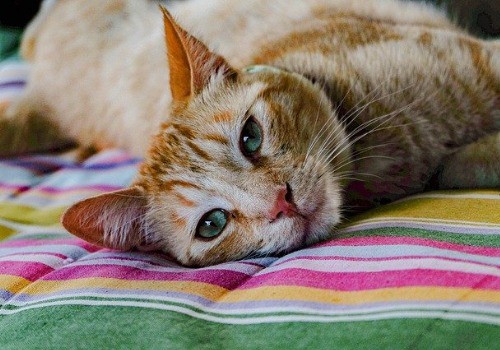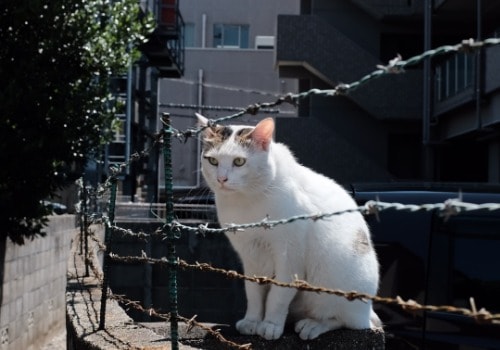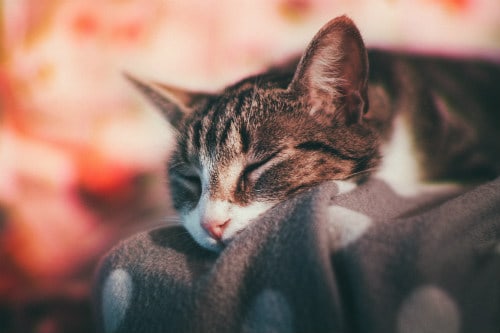Cats famously like to stay warm. They will lie in the sun, near a fire, or on a radiator. Still, there is such a thing as too much of a good thing. Cats can become overheated just like any other animal. The question is how hot does it have to be for that to happen.
How Well Do Cats Handle Hot Weather?
The domestic cat is descended from the African wildcat (Felis sylvestris lybica). This species, which still exists, lives mainly in deserts and other arid places. Domestic cats, therefore, evolved to live in hot and dry climates and can tolerate high temperatures.
The average shorthaired cat has a body temperature of 100° F (37.8° C), and longhaired cats have a somewhat higher body temperature on account of their fur. If a cat’s body temperature reaches above 105° F (40.6° C), they are developing hyperthermia, which is a fancy way of saying they are becoming overheated. Heat stroke is the most severe form of hyperthermia and can be lethal.
What Are the Symptoms of Hyperthermia?

In addition to a body temperature of over 105° F, a cat with hyperthermia can show the following symptoms:
- Panting
- Lethargy
- Rapid pulse and/or heartbeat
- Sweaty feet
- Trouble breathing
- Diarrhea and vomiting
- Loss of appetite
- Pronounced redness around the tongue and mouth
- Trouble walking
If the cat develops heatstroke, their body temperature could soar to 109 ° F (42. 8° C). They will feel notably hot and have glazed eyes. She may fall into a stupor and develop hemorrhages or bruises on her abdomen. She may also have seizures, which will damage her muscles and make her temperature rise even higher.
[amazon bestseller=”cat thermometer”]
How Can You Prevent a Cat from Getting Overheated?
An easy way to keep a cat from getting too hot is to keep them inside. The average room has a temperature of about 77° F (25° C) or a little less. That’s a perfectly comfortable temperature for both cats and humans. On a hot day, keep the air conditioner on, even if you aren’t home. The AC will keep your cat comfortably cool.
Make sure your cat has access to cool and fresh water. Some cats prefer drinking from a faucet, so run a tap if you’re worried that she might not be drinking enough from her water dish. You can also buy a water fountain designed for cats.
Make sure your cat can reach cool and shaded areas in your home, especially if you’re leaving her by herself. Cats will often retreat to places like closets or bathrooms when they need to cool off. Just makes sure that they don’t get trapped in such places.
Keep your cat’s bed off the ground, so air can flow under and around it and thus cool it off.
Put a damp towel by the window. The combination of a breeze and cool water can make your cat feel a lot cooler.
You can also buy a cooling mat from your local pet store. Resting on it will help lower the cat’s body temperature.
If your cat likes gravy or similar savory liquids, consider making her popsicles. She will enjoy licking them.
Never leave a cat in a locked car. During the summer, the temperature within the car can soar to 104° F (40° C) within 15 minutes. In fact, being left in a car is one of the most common causes of hyperthermia.
Brush your cat to remove dead fur. Many cats, especially longhairs, shed their winter coats as the weather gets warmer. You can help your cat stay cool and comfortable by removing some of that excess fur.
“My Cat Likes to Go Outside.”

Check the weather before letting your cat go outside. If it’s too hot for you, it’s also too hot for your cat. If you live in the suburbs or the city, put the back of your hand on the sidewalk to check how hot it is. If it feels uncomfortably hot or even burns your hand, it’s too hot for your cat’s paws. A backyard with a lot of grass will be a much safer option.
Similarly, pay attention to warnings like heat advisories.
[amazon bestseller=”Cat Harness”]
What to Do If Your Cat Does Get Overheated
If your cat shows signs of hyperthermia, you need to do the following:
Move the cat to a shady and cool place so she won’t get any hotter. Put her on top of a cool and wet towel or blanket.
Make a note of the time, for the vet will want to know.
If the cat is alert and can drink, offer her some cool water. Don’t give her ice-cold water, for that can chill her and cause other problems. Try to have her drink small amounts of water, but don’t force her to drink, and don’t pour the water down her throat.
Take the cat’s temperature with a rectal thermometer, preferably a digital thermometer. If her temperature is over 104° F, start trying to cool her off. Put her near a fan and spray cool water on her body. Stop once her temperature reaches 103.5° F (39.7° C).
Don’t use ice packs or extremely cold water, and don’t put her in a tub of water. Doing the latter will only scare her. Don’t try to cool your cat too quickly.
Call the vet and let them know that you’re bringing a cat that has had hyperthermia. Don’t skip the vet visit even if your cat seems to be better. She could have suffered damage to her internal organs, and her temperature could rise again.
How Will a Vet Treat Hyperthermia

The vet’s main priorities will be cooling the cat and ensuring she is properly hydrated. For example, they will put the cat on a drip or intravenous fluids to rehydrate them. If necessary, they will also administer medications or supplemental oxygen.
If hyperthermia gets severe enough, it can cause organ damage. The vet will thus perform blood tests to determine how well the cat’s organs are working.
[amazon bestseller=”cat water bowl”]
Which Cats Are Most Susceptible to Overheating?
Kittens and older adults are less able to handle extreme heat because their bodies don’t regulate temperature well. Overweight cats are also more susceptible to hyperthermia because their extra body fat absorbs more heat. Cats with respiratory or heart problems are also vulnerable to overheating.
Brachycephalic or flat-faced cats like the Persian, Himalayan or Exotic Shorthair are susceptible to hyperthermia. Persians suffer a double whammy as they also have the longest hair of all the domestic cats, and that coat increases their risk of overheating.
Cats with thick and dark coats are more susceptible than are cats with light and thin coats. Dark colors absorb heat far more readily than do light colors.
Longhaired cats are more susceptible to overheating than are shorthairs. At least some of these breeds, such as the Norwegian Forest Cat, Siberian, and Maine Coon, developed long hair to survive the intensely cold winters of their original homes. They thus don’t cope that well with hot weather.
Hairless cats like the Sphynx are vulnerable to extremes of both hot and cold and should thus be kept inside when it’s very hot or cold.
Dehydration in Cats
Cats that are becoming overheated will try to cool themselves. They only have sweat glands on their paws, so they need other ways to keep cool. Many of these are behavioral; a cat that’s getting hot will move to a cooler and shadier spot, for example.
A hot cat will also groom itself. When a human sweats, the subsequent evaporation helps cool them. Similarly, when a cat licks itself, the saliva evaporates and cools the cat.

Unfortunately, both sweating and grooming cause the cat to lose water, plus electrolytes like chloride, potassium, and sodium. If the cat can’t replace that water, it gets dehydrated.
The best-known symptom of dehydration in a cat is skin tenting. In a healthy cat, if you pinch a bit of skin, it will snap back into place as soon as you let go. If the cat is dehydrated, though, the skin will go back into place abnormally slowly. In severe cases, the skin stays up and looks a bit like a tent.
Other symptoms of dehydration include the following:
- Listlessness
- Refusal to eat
- Tacky and dry gums
- Sunken eyes
- Increased heart rate
- Panting
Dehydration is a serious and potentially fatal condition. If your cat is dehydrated, you need to get them to a vet immediately.
[amazon bestseller=”cat automatic water fountain”]
Can Cats Get Sunburn?
Yes. If a cat spends too much time out in the sun, they can get sunburn. Since shorthairs have less fur than longhaired cats, they also have less protection from the sun. White cats are especially susceptible to sunburn as are hairless cats.
Cats that lie on their back while sunbathing outside risk getting sunburn on their underbelly. You can protect your cat by applying sunblock. If you decide to do this, use a gentle and unscented brand designed for babies. You should use a sunblock with an SPF of at least 15.
Depending on how tolerant your cat is, you can also try having them wear a child’s shirt.
"In ancient times cats were worshipped as gods; they have not forgotten this."
-- Terry Pratchett






Please stop constantly referring to cats as “she” and “her”. I have two cats – both boys.
Please be quiet… you know Pat and Kay are both boys and Max and Zack are girls !!!
Thank you so much for the information, it is always good to be reminded of helpful ways to take care of your furry family members.